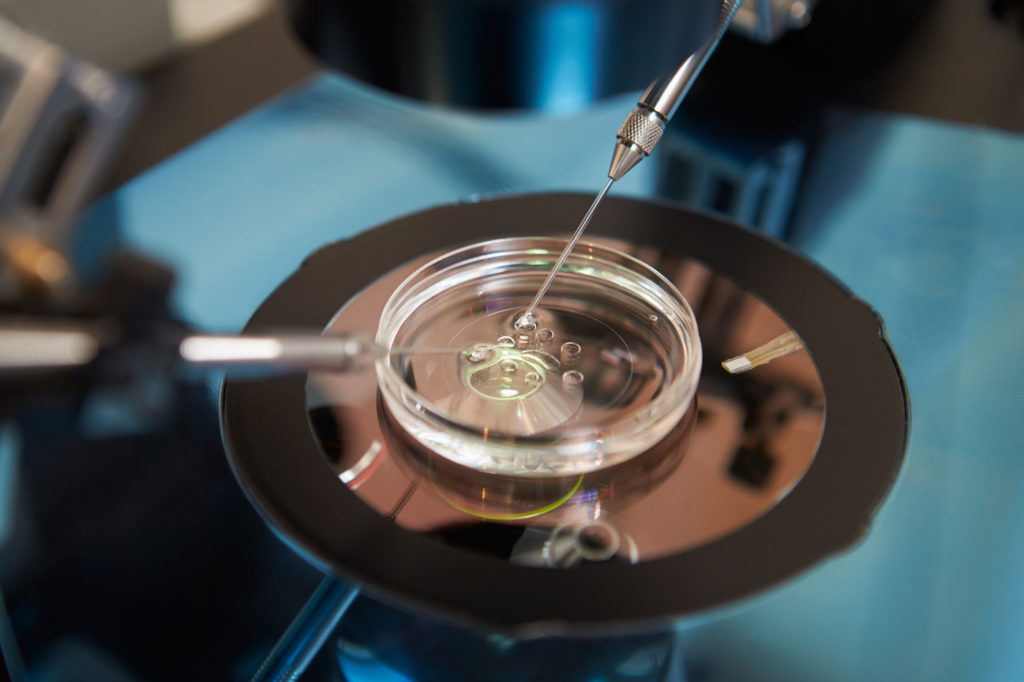For decades, a small but spirited movement has fought for the unborn. During this time, its primary front has been abortion, but it now needs to rethink its strategy in a post-Roe environment. The Dobbs ruling provides an opportunity for pro-lifers to open a second front against what may now present the greater threat to human life and dignity—in vitro fertilization (IVF).
IVF is the process of removing egg and sperm from their parents and combining them in vitro (“in glass”), in a laboratory. The resulting embryo is then implanted in the womb of either the mother or a surrogate. IVF may be used in conjunction with other reproductive technologies such as pre-implantation testing, and it often relies on donated eggs and sperm.
A Threat to Life and Dignity
Though many Americans, including pro-lifers, might not be familiar with the technology, IVF probably has a more destructive impact on unborn life than abortion. According to the latest statistics available from the CDC, in 2019, there were 330,773 reproductive cycles conducted by US fertility clinics, resulting in 83,946 live born infants. A third of these cycles were for banking where eggs or embryos are frozen for future use. The other cycles were attempts to conceive and bring to term a child. In the typical cycle, multiple eggs are retrieved and fertilized. The resulting embryos are sorted and one or more implanted. The leftover embryos are frozen, donated for research, or discarded. If the mother ends up with a multiple pregnancy, she may choose a “fetal reduction.”
Start your day with Public Discourse
Sign up and get our daily essays sent straight to your inbox.In other words, to bring one child to life normally involves sacrificing other embryos, often many. In one study, the median number of eggs retrieved per cycle was nine, with five being successfully fertilized. If we calculate using this median rate, in 2019 out of a million embryos involved in IVF cycles, 84,000 made it to term—the remaining 900,000 did not. By comparison, in the same year, the CDC reported 629,898 abortions. Both figures are inaccurate and out of date, but the basic comparison holds: death by IVF probably exceeds death by abortion.
This disregard for life is exacerbated by the fact that the fertility industry is a competitive business. The CDC tracks success rates of clinics so that consumers can choose where to take their business. This provides a strong incentive for clinics to harvest and fertilize an optimum number of embryos. For example, the study referenced above found a strong connection between live-birth rates and the number of eggs retrieved, maxing at fifteen eggs. Following this guidance, a clinic will want to maximize its retrieval and fertilization of eggs.
We may think: if a couple only fertilizes one egg, is IVF acceptable? Some would argue that it is, but this ignores the fundamental question of human dignity. As with abortion, IVF not only threatens the lives of the unborn—it disrespects them. Children may reasonably claim certain rights, such as being conceived in the loving embrace of a husband and wife, or—in the case of surrogacy—being brought to term in their mother. These are rights that preserve the inherent dignity of the child.
IVF and its related technologies inevitably treat children not as people but as the objects of manufacture. At every step of the process, embryos are processed and graded with the goal of quality control. Embryos that don’t make the cut on this human assembly line can be easily discarded.
This commodification of the human person is aggravated by the high costs of these technologies. Poor people do not use IVF to have babies. However, they may be used by IVF to provide the donor gametes and rented wombs that are increasingly the stock in trade of the billion-dollar fertility industry. If we are disturbed by the amount of money that fuels abortion, we should be appalled by the money that goes into the manufacture of babies. There are certain things that just should not be for sale—like eggs and wombs.
If we are disturbed by the amount of money that fuels abortion, we should be appalled by the money that goes into the manufacture of babies.
This threat to dignity is not just to the children involved in IVF but to the whole of society. We have seen clearly over the decades how the abortion license has lowered our respect for the human person at all stages of life. IVF is gradually having the same effect: a community that denies civil protection to its most vulnerable members is on a slippery slope where it becomes easier to deny that protection to everyone else.
Lack of Consensus
Depressingly, many American pro-life organizations have little or nothing to say about IVF. (A few do.) This general silence undoubtedly reflects the lack of consensus among pro-lifers themselves. Many who are adamant in their opposition to abortion have not made up their minds about IVF.
On the face of it, infertile couples are “pro-life” in their desire to have children. We can affirm this good intent. We should also recognize that many couples start down the path of IVF without really understanding where it leads. Fertility clinics are into sales, not ensuring that couples fully grasp the moral and health risks of IVF. We need a charitable attitude toward couples who are struggling with infertility. Still, good intent and lack of knowledge cannot justify actions that are objectively wrong.
Religious communities also have not reached a consensus on these technologies. Most recognize that there should be limits. There’s a general sense that we should proceed cautiously with technologies still on the horizon. And many understand that over time these technologies will change the institutions of marriage and family—although for some, this is a welcome change.
There is a notable exception to this lack of consensus: the Catholic Church has said from the outset that fertility medicine must only assist the natural process—where conception takes place in the marital embrace and the baby comes to term in the mother’s womb. This disallows IVF and its associated technologies, though the Church also stresses that all life, regardless of its origin, is beautiful and valuable. As in the early years of the Roe regime, Catholics have demonstrated compassionate leadership within the context of IVF by opposing the process while celebrating all forms of life.
A Two-Pronged Strategy
A culture of life cannot support reproductive technologies that threaten the life and dignity of our children. Therefore, the pro-life movement needs to open a second front on IVF in light of the Dobbs decision.
The pro-life approach to abortion has always been two-pronged—both restricting it and building an infrastructure of support for mothers and children. A similar strategy presents itself for IVF—both limiting its use and supporting good fertility clinics.
As with abortion, restricting IVF requires changing attitudes as well as laws. In this respect, the United States lags other countries. In some countries we find more cautious attitudes toward these technologies. These countries already restrict or ban commercial surrogacy, limit how many embryos can be created per cycle, curtail the use of pre-implantation genetic testing (PGT), and prohibit the cryopreservation or destruction of excess embryos. In contrast, American law is so lax that we have spawned fertility tourism—foreigners come here to do what is illegal back home.
American law is so lax that we have spawned fertility tourism—foreigners come here to do what is illegal back home.
Fertility law is a natural focus for the prolife movement because the fertility industry is law–dependent, especially when it concerns a third party. Contract law is essential for both egg/embryo donation and surrogacy where providers and recipients must agree over such issues as parental rights and donor health information.
We need a coherent strategy for changing laws and hearts over IVF. An obvious starting point is those still emerging technologies that are especially problematic, for example, in vitro gametogenesis (IVG), which would manufacture gametes from the genetic material of multiple parents. We can follow the lead of other countries in restricting the use of genetic testing for things such as gender selection or limiting the number of embryos created. Banning the cryopreservation of embryos recognizes that having large numbers of embryos in cold storage is an unsolvable moral dilemma. We can certainly further restrict the use of excess embryos in research.
In addition, the pro-life movement should not only be against IVF but for good fertility care. We already have excellent fertility clinics that assist couples in having children naturally. They do what medicine should do, providing interventions that enable the human body to function as intended. Unfortunately, these clinics are currently too few, and we need to change that. As we have built crisis pregnancy centers, we need to build fertility clinics with doctors who have the skill and patience to help couples have children the old-fashioned way.
Couples enter the fertility clinic with the best of intentions—they want a child! Regrettably, they are met by medical personnel who eagerly push them down the more lucrative IVF path instead of taking the time to address underlying issues. The reality is that there are many acceptable medical and surgical therapies available to couples challenged with infertility. At the top of the list are natural family planning techniques that assist couples in charting their cycles and increasing their chances of becoming pregnant.
Risks and Opportunities
If the pro-life movement fails to take the initiative on IVF, the fertility industry will. It has already made the connection between abortion and fertility law, especially in the wake of Dobbs. If pro-lifers continue to ignore this issue, they will find themselves in the increasingly untenable position of defending the civil rights of the unborn in abortion but not in IVF. In contrast, a well-conceived second front on IVF can strengthen the push against abortion.
A new initiative on IVF helps focus the legal question that is central to both IVF and abortion—when do our children fall under the protection of the Constitution? IVF sharpens this question because, as noted, the fertility industry is law-dependent. You don’t need a lawyer to get an abortion but probably will if you’re using third-party reproductive technologies. This provides a natural opening for the pro-life movement to push the legal status of the unborn.
IVF also provides an opportunity for us to emphasize the importance of science and reason. Our positions on abortion and IVF are not just opinions—they are grounded in biology and logic. For decades, we have pointed out the medical facts of abortion. We need to do the same with IVF and its related technologies. Public support of these practices depends on a level of ignorance, the ability to pass them off as simply “procedures” without getting into their grim realities. If potential American parents really understand what IVF and related technologies involve, many will decide not to go that route.
Now is the time for those of us enlisted in the cause for life to reconsider our strategy—considering both Dobbs and IVF.













